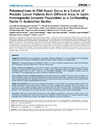Please use this identifier to cite or link to this item:
https://accedacris.ulpgc.es/jspui/handle/10553/43048
| Title: | Polymorphisms in DNA-Repair Genes in a Cohort of Prostate Cancer Patients from Different Areas in Spain: Heterogeneity between Populations as a Confounding Factor in Association Studies | Authors: | Henríquez-Hernández, Luis Alberto Valenciano, Almudena Foro-Arnalot, Palmira Álvarez-Cubero, María Jesús Cozar, José Manuel Suárez-Novo, José Francisco Castells-Esteve, Manel Ayala-Gil, Adriana Fernández-Gonzalo, Pablo Ferrer, Montse Guedea, Ferrán Sancho-Pardo, Gemma Craven-Bartle, Jordi Ortiz-Gordillo, María José Cabrera-Roldán, Patricia Herrera-Ramos, Estefanía Lara, Pedro C. |
UNESCO Clasification: | 32 Ciencias médicas | Keywords: | Normal Tissue Toxicity Breast-Cancer Radiotherapy Toxicity Radiation Toxicity Stratification, et al |
Issue Date: | 2013 | Journal: | PLoS ONE | Abstract: | Background: Differences in the distribution of genotypes between individuals of the same ethnicity are an important confounder factor commonly undervalued in typical association studies conducted in radiogenomics.Objective: To evaluate the genotypic distribution of SNPs in a wide set of Spanish prostate cancer patients for determine the homogeneity of the population and to disclose potential bias.Design, Setting, and Participants: A total of 601 prostate cancer patients from Andalusia, Basque Country, Canary and Catalonia were genotyped for 10 SNPs located in 6 different genes associated to DNA repair: XRCC1 (rs25487, rs25489, rs1799782), ERCC2 (rs13181), ERCC1 (rs11615), LIG4 (rs1805388, rs1805386), ATM (rs17503908, rs1800057) and P53 (rs1042522). The SNP genotyping was made in a Biotrove OpenArray (R) NT Cycler.Outcome Measurements and Statistical Analysis: Comparisons of genotypic and allelic frequencies among populations, as well as haplotype analyses were determined using the web-based environment SNPator. Principal component analysis was made using the SnpMatrix and XSnpMatrix classes and methods implemented as an R package. Non-supervised hierarchical cluster of SNP was made using MultiExperiment Viewer.Results and Limitations: We observed that genotype distribution of 4 out 10 SNPs was statistically different among the studied populations, showing the greatest differences between Andalusia and Catalonia. These observations were confirmed in cluster analysis, principal component analysis and in the differential distribution of haplotypes among the populations. Because tumor characteristics have not been taken into account, it is possible that some polymorphisms may influence tumor characteristics in the same way that it may pose a risk factor for other disease characteristics.Conclusion: Differences in distribution of genotypes within different populations of the same ethnicity could be an important confounding factor responsible for the lack of validation of SNPs associated with radiation-induced toxicity, especially when extensive meta-analysis with subjects from different countries are carried out. | URI: | https://accedacris.ulpgc.es/handle/10553/43048 | ISSN: | 1932-6203 | DOI: | 10.1371/journal.pone.0069735 | Source: | PLoS ONE [ISSN 1932-6203], v. 8 (7), e69735, (Julio 2013) |
| Appears in Collections: | Artículos |
SCOPUSTM
Citations
11
checked on Jun 8, 2025
WEB OF SCIENCETM
Citations
10
checked on Jun 8, 2025
Page view(s)
90
checked on Nov 23, 2024
Download(s)
85
checked on Nov 23, 2024
Google ScholarTM
Check
Altmetric
Share
Export metadata
Items in accedaCRIS are protected by copyright, with all rights reserved, unless otherwise indicated.
